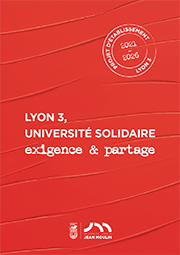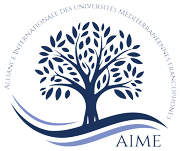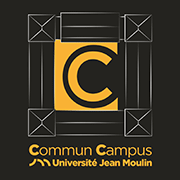AccueilRechercheProgrammes et productions scientifiquesThèsesThèses soutenuesThèses soutenues - 2006-2021Thèses soutenues - 2017
-
Partager cette page
- Recherche,
BRUNO Tino
D’Hiroshima à T?kaimura (1945-1957) : Pour une histoire culturelle de la genèse du projet nucléaire civil japonais à travers les quotidiens Asahi Shinbun et Yomiuri Shinbun
Publié le 25 septembre 2017 – Mis à jour le 3 octobre 2017
Thèse en ?tudes de l’Asie et ses Diasporas, soutenue le 21 septembre 2017.
Au-delà des questions inhérentes à la s?reté des installations nucléaires l’accident de la centrale Fukushima Dai’ichi du 11 mars 2011 a fait ressurgir ce que certains considèrent comme un paradoxe : le Japon s’est lancé dans l’aventure du nucléaire alors qu’il avait lui-même été victime de la bombe atomique et que, de surcro?t, il est régulièrement confronté à des catastrophes naturelles.
Par ailleurs, la catastrophe de Fukushima a encouragé une certaine réflexion sur les médias japonais, qui vise particulièrement à critiquer le r?le que ceux-ci ont joué dans la promotion du nucléaire et son acceptation auprès du public japonais dès après la Seconde guerre mondiale.
En s'inscrivant dans le champ des études en histoire culturelle, le présent travail vise ainsi à comprendre, à travers le prisme de l'image médiatique, comment le Japon a opéré une transition entre Hiroshima (1945) et T?kaimura (1957), autrement dit entre le nucléaire militaire et le nucléaire civil, en attachant une importance particulière à la manière dont les discours sur ces "deux nucléaires" ont été articulés dans la presse japonaise. Pour ce faire, nous analysons la manière dont les grands quotidiens nationaux Asahi Shinbun et Yomiuri Shinbun ont traité de l’énergie atomique durant la genèse du projet nucléaire civil japonais (1945-1957), une période charnière démarrant avec les bombardements atomiques d’Hiroshima et de Nagasaki et se cl?turant avec la mise en route du tout premier réacteur nucléaire expérimental japonais à T?kaimura.
? travers un plan structuré chronologiquement autour de quatre périodes, nous tentons donc de fournir des éléments de réponse à la question suivante : comment l’énergie nucléaire civile a-t-elle été représentée dans la presse nationale japonaise à l’époque de son introduction dans l’archipel ?
Dans la première partie (1945-1949), nous observons comment l’énergie nucléaire a été représentée durant les premières années suivant les bombardements atomiques sur Hiroshima et Nagasaki, alors que le discours sur le nucléaire militaire était censuré par les Forces Alliées et que l’énergie nucléaire civile n’en était encore qu’à ses balbutiements. Dans la deuxième partie (1949-1952), nous analysons comment le socle des représentations de cette énergie évolue alors que la menace de la guerre nucléaire fait surface et que les premiers succès de production d’électricité nucléaire à l’étranger attirent l’attention de la presse japonaise. Notre troisième période (1953-1955) s’intéresse à trois évènements médiatiques qui ont influencé le discours médiatique autour de l’énergie nucléaire : le discours américain Atoms for Peace ; l’incident du thonier Daigo Fukury? Maru ; et la venue de l’industriel américain John Jay Hopkins sur l’invitation de Sh?riki Matstutar?, alors à la tête du quotidien Yomiuri Shinbun. Enfin, dans notre dernière partie (1955-1957) nous analysons tout d’abord la manière dont le quotidien Yomiuri Shinbun a couvert une grande exposition sur "les usages pacifiques" de l’énergie nucléaire qu’il avait lui-même co-organisé avec l’United States Information Agency pour améliorer l’image de cette dernière après l’incident du Daigo Fukury? Maru. Dans un second temps, nous nous intéressons aux débats politiques à l’heure où le Japon commence à institutionnaliser son projet nucléaire civil. Enfin, nous cl?turons cette dernière partie en traitant d’un événement qui devait symboliser l’aboutissement du projet nucléaire civil japonais : la mise en marche du tout premier réacteur nucléaire expérimental du Japon, dans le village de T?kaimura.
In addition to questions that are inherent to the safety of nuclear installations, the accident at Fukushima Dai’ichi Nuclear Power Plant of March 2011 raised what can be considered a paradox: Japan has embarked on a nuclear adventure even though it has been the victim of a nuclear bomb itself and while it regularly faces natural catastrophes.
Furthermore, the Fukushima catastrophe has encouraged some reflexion on the Japanese media, with special focus on the role these have played in the promotion of nuclear energy and in its acceptance by the Japanese public after the Second World War.
This study, which belongs to the field of cultural history, aims at understanding through the prism of the media image, in what way Japan has accomplished a transition between Hiroshima (1945) and T?kaimura (1957); in other words between military nuclear power and civilian nuclear energy, while attaching special importance to how the debate about these two aspects of the nuclear reality has been articulated in the Japanese press. To do this, we analyse the manner in which the big national newspapers: the Asahi Shinbun and Yomiuri Shinbun, dealt with atomic energy during the establishment of the Japanese civilian nuclear project (1945-1957), a pivotal period which started with the atomic bombings of Hiroshima and Nagasaki and closed with the start-up of the first Japanese experimental nuclear reactor in T?kaimura.
By means of a plan that is structured chronologically around four periods we will try to provide answers to the following question: how was civilian nuclear energy represented in the Japanese national press at the time of its introduction in the archipelago?
In the first period (1945-1949), we observe how nuclear energy was represented during the first years following the atomic bombings of Hiroshima and Nagasaki, at a time that any discussion about atomic bombings was censured by the Allied Forces and that civilian nuclear energy was still in its infancy. In the second period (1949-1952), we analyse how the base of the representations of that energy evolves while the threat of nuclear war surfaces and while the first successes of the production of nuclear energy draw the attention of the Japanese press. Our third period (1953-1955) focuses on three media events which influenced the debate around nuclear energy: the American speech Atoms for Peace; the incident of the tuna fishing boat Daigo Fukury? Maru and the arrival of the American industrialist John Jay Hopkins at the invitation of Sh?riki Matstutar?, the head of the daily newspaper Yomiuri Shinbun. Finally, in our last period (1955-1957) we analyse first of all the manner in which the Yomiuri Shinbun covered the great exhibition on ‘the pacific uses of nuclear energy’ which it had itself co-organized with the United States Information Agency after the Daigo Fukury? Maru incident, in order to improve the image of the latter. Then, we examine the political debates at the time that Japan began to institutionalize its nuclear civilian project. Lastly we end this part discussing an event that should symbolize the successful conclusion of the Japanese nuclear project: the start-up of the first experimental nuclear reactor in Japan in the village of T?kaimura.
Mots-clés :
médias, histoire culturelle, Japon, énergie nucléaire ; Yomiuri Shinbun ; Asahi Shinbun ; représentations ; bombardements atomiques ; réacteur nucléaire.
Keywords :
media ; cultural history ; Japan ; nuclear energy ; Yomiuri Shinbun ; Asahi Shinbun ; representations ; atomic bombings ; nuclear reactor.
Directeur(s).trice(s) de thèse : M . Jean-Pierre GIRAUD.
Par ailleurs, la catastrophe de Fukushima a encouragé une certaine réflexion sur les médias japonais, qui vise particulièrement à critiquer le r?le que ceux-ci ont joué dans la promotion du nucléaire et son acceptation auprès du public japonais dès après la Seconde guerre mondiale.
En s'inscrivant dans le champ des études en histoire culturelle, le présent travail vise ainsi à comprendre, à travers le prisme de l'image médiatique, comment le Japon a opéré une transition entre Hiroshima (1945) et T?kaimura (1957), autrement dit entre le nucléaire militaire et le nucléaire civil, en attachant une importance particulière à la manière dont les discours sur ces "deux nucléaires" ont été articulés dans la presse japonaise. Pour ce faire, nous analysons la manière dont les grands quotidiens nationaux Asahi Shinbun et Yomiuri Shinbun ont traité de l’énergie atomique durant la genèse du projet nucléaire civil japonais (1945-1957), une période charnière démarrant avec les bombardements atomiques d’Hiroshima et de Nagasaki et se cl?turant avec la mise en route du tout premier réacteur nucléaire expérimental japonais à T?kaimura.
? travers un plan structuré chronologiquement autour de quatre périodes, nous tentons donc de fournir des éléments de réponse à la question suivante : comment l’énergie nucléaire civile a-t-elle été représentée dans la presse nationale japonaise à l’époque de son introduction dans l’archipel ?
Dans la première partie (1945-1949), nous observons comment l’énergie nucléaire a été représentée durant les premières années suivant les bombardements atomiques sur Hiroshima et Nagasaki, alors que le discours sur le nucléaire militaire était censuré par les Forces Alliées et que l’énergie nucléaire civile n’en était encore qu’à ses balbutiements. Dans la deuxième partie (1949-1952), nous analysons comment le socle des représentations de cette énergie évolue alors que la menace de la guerre nucléaire fait surface et que les premiers succès de production d’électricité nucléaire à l’étranger attirent l’attention de la presse japonaise. Notre troisième période (1953-1955) s’intéresse à trois évènements médiatiques qui ont influencé le discours médiatique autour de l’énergie nucléaire : le discours américain Atoms for Peace ; l’incident du thonier Daigo Fukury? Maru ; et la venue de l’industriel américain John Jay Hopkins sur l’invitation de Sh?riki Matstutar?, alors à la tête du quotidien Yomiuri Shinbun. Enfin, dans notre dernière partie (1955-1957) nous analysons tout d’abord la manière dont le quotidien Yomiuri Shinbun a couvert une grande exposition sur "les usages pacifiques" de l’énergie nucléaire qu’il avait lui-même co-organisé avec l’United States Information Agency pour améliorer l’image de cette dernière après l’incident du Daigo Fukury? Maru. Dans un second temps, nous nous intéressons aux débats politiques à l’heure où le Japon commence à institutionnaliser son projet nucléaire civil. Enfin, nous cl?turons cette dernière partie en traitant d’un événement qui devait symboliser l’aboutissement du projet nucléaire civil japonais : la mise en marche du tout premier réacteur nucléaire expérimental du Japon, dans le village de T?kaimura.
In addition to questions that are inherent to the safety of nuclear installations, the accident at Fukushima Dai’ichi Nuclear Power Plant of March 2011 raised what can be considered a paradox: Japan has embarked on a nuclear adventure even though it has been the victim of a nuclear bomb itself and while it regularly faces natural catastrophes.
Furthermore, the Fukushima catastrophe has encouraged some reflexion on the Japanese media, with special focus on the role these have played in the promotion of nuclear energy and in its acceptance by the Japanese public after the Second World War.
This study, which belongs to the field of cultural history, aims at understanding through the prism of the media image, in what way Japan has accomplished a transition between Hiroshima (1945) and T?kaimura (1957); in other words between military nuclear power and civilian nuclear energy, while attaching special importance to how the debate about these two aspects of the nuclear reality has been articulated in the Japanese press. To do this, we analyse the manner in which the big national newspapers: the Asahi Shinbun and Yomiuri Shinbun, dealt with atomic energy during the establishment of the Japanese civilian nuclear project (1945-1957), a pivotal period which started with the atomic bombings of Hiroshima and Nagasaki and closed with the start-up of the first Japanese experimental nuclear reactor in T?kaimura.
By means of a plan that is structured chronologically around four periods we will try to provide answers to the following question: how was civilian nuclear energy represented in the Japanese national press at the time of its introduction in the archipelago?
In the first period (1945-1949), we observe how nuclear energy was represented during the first years following the atomic bombings of Hiroshima and Nagasaki, at a time that any discussion about atomic bombings was censured by the Allied Forces and that civilian nuclear energy was still in its infancy. In the second period (1949-1952), we analyse how the base of the representations of that energy evolves while the threat of nuclear war surfaces and while the first successes of the production of nuclear energy draw the attention of the Japanese press. Our third period (1953-1955) focuses on three media events which influenced the debate around nuclear energy: the American speech Atoms for Peace; the incident of the tuna fishing boat Daigo Fukury? Maru and the arrival of the American industrialist John Jay Hopkins at the invitation of Sh?riki Matstutar?, the head of the daily newspaper Yomiuri Shinbun. Finally, in our last period (1955-1957) we analyse first of all the manner in which the Yomiuri Shinbun covered the great exhibition on ‘the pacific uses of nuclear energy’ which it had itself co-organized with the United States Information Agency after the Daigo Fukury? Maru incident, in order to improve the image of the latter. Then, we examine the political debates at the time that Japan began to institutionalize its nuclear civilian project. Lastly we end this part discussing an event that should symbolize the successful conclusion of the Japanese nuclear project: the start-up of the first experimental nuclear reactor in Japan in the village of T?kaimura.
Mots-clés :
médias, histoire culturelle, Japon, énergie nucléaire ; Yomiuri Shinbun ; Asahi Shinbun ; représentations ; bombardements atomiques ; réacteur nucléaire.
Keywords :
media ; cultural history ; Japan ; nuclear energy ; Yomiuri Shinbun ; Asahi Shinbun ; representations ; atomic bombings ; nuclear reactor.
Directeur(s).trice(s) de thèse : M . Jean-Pierre GIRAUD.
Membres du jury :
M. Micha?l LUCKEN, Rapporteur, Professeur des universités, INALCO, Paris,
M. Thierry RIBAULT, Rapporteur, Chargé de recherches HDR, CNRS, Université de Lille I,
M. Christian GALAN, Professeur des universités, Université Toulouse Jean Jaurès,
Mme Cléa PATIN-MIYAMOTO, Ma?tre de conférences, Université Jean Moulin Lyon 3,
Mme Ayame HOSOI, Ma?tre de conférences, Université Jean Moulin Lyon 3,
M. Jean-Pierre GIRAUD, Directeur de thèse, Professeur des universités, Université Jean Moulin Lyon 3.
Président.e du jury : M. Christian GALAN
Equipe d'accueil : IETT
M. Thierry RIBAULT, Rapporteur, Chargé de recherches HDR, CNRS, Université de Lille I,
M. Christian GALAN, Professeur des universités, Université Toulouse Jean Jaurès,
Mme Cléa PATIN-MIYAMOTO, Ma?tre de conférences, Université Jean Moulin Lyon 3,
Mme Ayame HOSOI, Ma?tre de conférences, Université Jean Moulin Lyon 3,
M. Jean-Pierre GIRAUD, Directeur de thèse, Professeur des universités, Université Jean Moulin Lyon 3.
Président.e du jury : M. Christian GALAN
Equipe d'accueil : IETT
Décision : Admis
Documentation
Mise à jour : 3 octobre 2017







